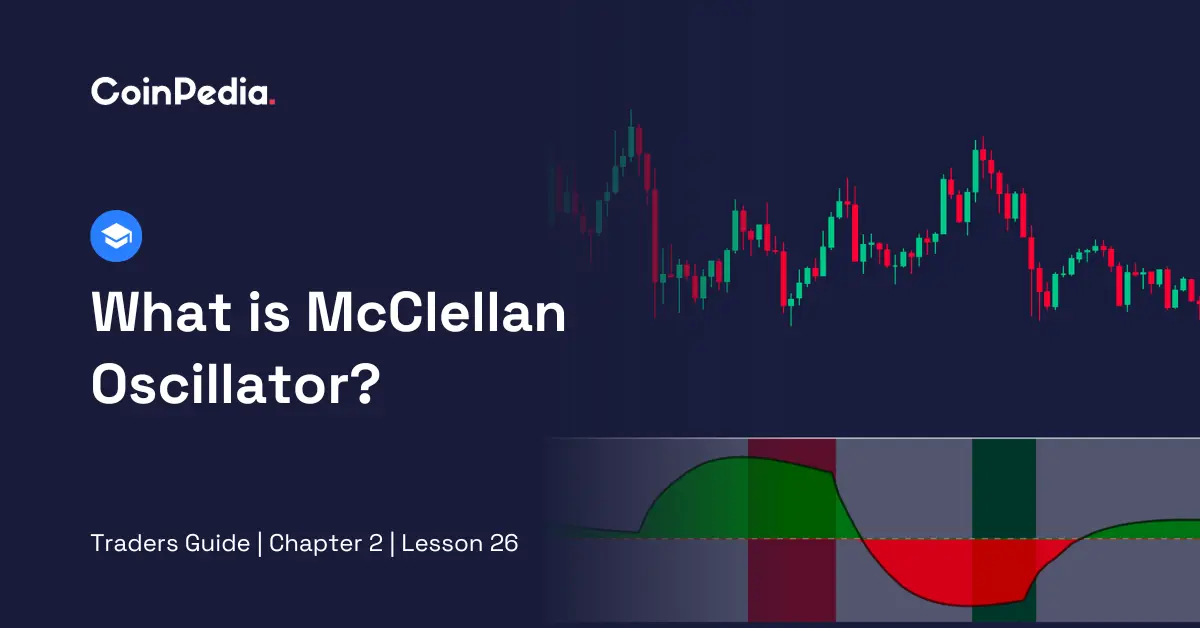
Market breadth indicators are unique as they provide a holistic view of the health and sentiment of the entire crypto market or specific tokens. They help crypto traders and investors confirm trends, assess the overall strength of the market, and identify potential opportunities or risks by analysing a broad spectrum of cryptocurrencies rather than focusing on individual coins. McClellan Oscillator is one of the popular market breadth indicators. Let’s learn about this indicator in depth.
A popular market breadth indicator, McClellan Oscillator, subtracts the number of advancing assets from the number of declining assets. When the oscillator rises above the neutral point, it indicates market strength; when it falls below, it suggests a weaker market.
The McClellan Oscillator indicator was created by Sherman and Marian McClellan in the 1960s to measure market breadth. They wanted a way to see if more stocks were advancing or declining. By subtracting these numbers, they developed an indicator that shows market strength. It helps traders identify buying (above neutral) and selling (below neutral) opportunities based on market sentiment.
The McClellan Oscillator indicator is calculated in four steps.
| McClellan Oscillator = 39-day EMA of (Advancing Issues – Declining Issues) – 19-day EMA of (Advancing Issues – Declining Issues) |
The below is the steps to launch the McClellan Oscillator indicator on a TradingView chart.
Go to the TradingView website and log in to your trading account
After logging in, click on the search option, which is usually located at the top of the TradingView platform.
Select the cryptocurrency you want to analyse and add it to your chart,
Look for the ‘Indicators’ button on the top menu or in the chart settings. Click on it.
In the indicator search bar, type ‘McClellan Oscillator’.
Click on the McClellan Oscillator in the search result, and it will be added to your chart.
You can usually customise the McClellan Oscillator settings, like the period or the type of moving average.
You can now analyse the indicator to make trading decisions.
Also Read: DPO and Crypto: A Winning Combination for Cryptocurrency Traders
The McClellan Oscillator can provide important signals for crypto trading.
When the oscillator is positive, it usually indicates that more cryptocurrencies are advancing than declining. This suggests market strength. It is a good sign for potential buying opportunities.
Conversely, when the oscillator is negative, it means more cryptocurrencies are declining than advancing. This could signal market weakness, and it might be a time to be cautious about buying or consider selling.
Pay attention to the points where the McClellan Oscillator crosses from negative to positive or vice versa. A positive-to-negative crossover can be a signal to be cautious or consider selling, while a negative-to-positive crossover may indicate it is good time to consider buying.
Extremely high positive values or extremely low negative values can suggest overbought or oversold conditions in the market. These extremes might signal potential reversals in the market trend.
The McClellan Oscillator indicator can also provide divergence signals. Divergence occurs when the indicator’s movements don’t align with the price movements of the cryptocurrency you are analysing.
This occurs when the McClellan Oscillator is making higher highs, while the price of the cryptocurrency is making lower lows. It suggests that despite the price falling. There is still underlying strength in the market. Traders might see this as a potential buying opportunity.
This happens when the McClellan Oscillator is making lower highs while the crypto’s price is making higher highs. This can indicate that even though prices are rising, there may be underlying weakness in the market. Traders might consider this a sign to be cautious about buying or think about selling.
The McClellan Oscillator indicator is a powerful tool. It helps measure the strength of the market by tracking the balance between advancing and declining assets. Positive readings indicate market strength, while negative readings suggest caution or selling. Extreme values may indicate overbought or oversold conditions. These insights can aid newcomers in making informed trading decisions. Though it is an indicator known for its high accuracy, it is always better to use this indicator in combination with other indicators.
CoinPedia has been delivering accurate and timely cryptocurrency and blockchain updates since 2017. All content is created by our expert panel of analysts and journalists, following strict Editorial Guidelines based on E-E-A-T (Experience, Expertise, Authoritativeness, Trustworthiness). Every article is fact-checked against reputable sources to ensure accuracy, transparency, and reliability. Our review policy guarantees unbiased evaluations when recommending exchanges, platforms, or tools. We strive to provide timely updates about everything crypto & blockchain, right from startups to industry majors.
All opinions and insights shared represent the author's own views on current market conditions. Please do your own research before making investment decisions. Neither the writer nor the publication assumes responsibility for your financial choices.
Sponsored content and affiliate links may appear on our site. Advertisements are marked clearly, and our editorial content remains entirely independent from our ad partners.
A new report by blockchain analytics firm AMLBot has revealed major differences in how the…
SBI Ripple Asia has signed an agreement with Doppler Finance to explore new financial products…
Christmas week is here, and Bitcoin investors are waiting to see if the market delivers…
As 2025 comes to an end, the crypto market looks very different from last year.…
Avalanche’s AVAX token is trading at $12.24, marking a more than 60% drop in value…
In crypto markets, price does not always move in smooth trends. It often jumps in…